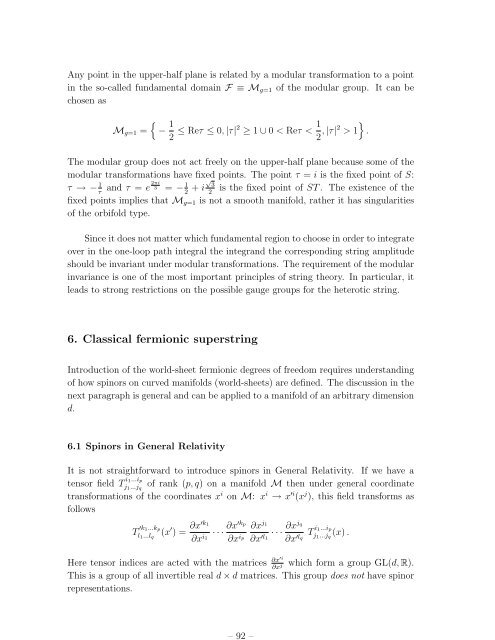Lectures on String Theory
Lectures on String Theory
Lectures on String Theory
Create successful ePaper yourself
Turn your PDF publications into a flip-book with our unique Google optimized e-Paper software.
– 92 –<br />
Any point in the upper-half plane is related by a modular transformati<strong>on</strong> to a point<br />
in the so-called fundamental domain F ≡ M g=1 of the modular group. It can be<br />
chosen as<br />
{<br />
M g=1 =<br />
− 1 2 ≤ Reτ ≤ 0, |τ|2 ≥ 1 ∪ 0 < Reτ < 1 }<br />
2 , |τ|2 > 1 .<br />
The modular group does not act freely <strong>on</strong> the upper-half plane because some of the<br />
modular transformati<strong>on</strong>s have fixed points. The point τ = i is the fixed point of S:<br />
τ → − 1 2πi<br />
and τ = e<br />
τ<br />
3 = − 1 + i √ 3 is the fixed point of ST . The existence of the<br />
2 2<br />
fixed points implies that M g=1 is not a smooth manifold, rather it has singularities<br />
of the orbifold type.<br />
Since it does not matter which fundamental regi<strong>on</strong> to choose in order to integrate<br />
over in the <strong>on</strong>e-loop path integral the integrand the corresp<strong>on</strong>ding string amplitude<br />
should be invariant under modular transformati<strong>on</strong>s. The requirement of the modular<br />
invariance is <strong>on</strong>e of the most important principles of string theory. In particular, it<br />
leads to str<strong>on</strong>g restricti<strong>on</strong>s <strong>on</strong> the possible gauge groups for the heterotic string.<br />
6. Classical fermi<strong>on</strong>ic superstring<br />
Introducti<strong>on</strong> of the world-sheet fermi<strong>on</strong>ic degrees of freedom requires understanding<br />
of how spinors <strong>on</strong> curved manifolds (world-sheets) are defined. The discussi<strong>on</strong> in the<br />
next paragraph is general and can be applied to a manifold of an arbitrary dimensi<strong>on</strong><br />
d.<br />
6.1 Spinors in General Relativity<br />
It is not straightforward to introduce spinors in General Relativity. If we have a<br />
tensor field T i 1...i p<br />
j 1 ...j q<br />
of rank (p, q) <strong>on</strong> a manifold M then under general coordinate<br />
transformati<strong>on</strong>s of the coordinates x i <strong>on</strong> M: x i → x ′i (x j ), this field transforms as<br />
follows<br />
T ′k 1...k p<br />
l 1 ...l q<br />
(x ′ ) = ∂x′k 1<br />
∂x · · · ∂x′k p<br />
i 1 ∂x i p<br />
∂x j 1<br />
∂x ′l 1 · · · ∂xj q<br />
∂x ′l q<br />
T i 1...i p<br />
j 1 ...j q<br />
(x) .<br />
Here tensor indices are acted with the matrices ∂x′i which form a group GL(d, R).<br />
∂x j<br />
This is a group of all invertible real d × d matrices. This group does not have spinor<br />
representati<strong>on</strong>s.

















